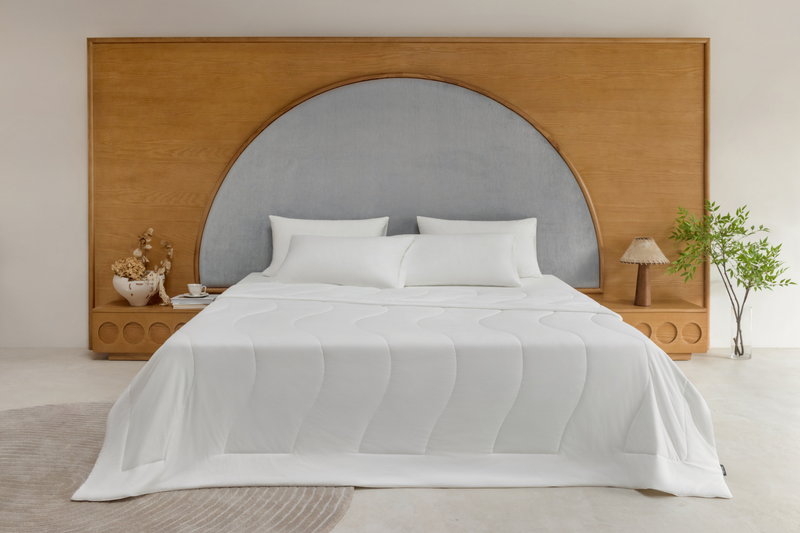Top 5 Best Hypoallergenic Comforter Reviews in 2026
Your morning can be quickly ruined if you wake up with itchy eyes or a stuffy nose. Common allergens that make it difficult to get a good night's sleep include mould, dust mites, and pet dander. By selecting the correct comforter, you may achieve a cleaner, healthier sleeping environment and lessen these irritants.
A high-quality, allergy-resistant duvet insert removes dust and dander from your bed and improves comfort. You can wake up feeling clear and rejuvenated thanks to the cosiness and reduction of triggers provided by soft, breathable fabrics.
5 Best Hypoallergenic Comforters
1. Evercool® Cooling Comforter

The Evercool comforter is made for hot sleepers who want a lightweight comforter that truly stays cool. The fabric has an instant cooling feel, while Sorona and TENCEL® fibers work to wick away moisture so you don’t wake up sweaty. It’s hypoallergenic, pet-friendly, and machine washable, which makes it easy to care for. If you live in a warm climate or tend to overheat at night, this comforter is a great fit, though it may feel too light for winter use.
Pros
-
Fabric feels cool against the skin
-
Breathable and moisture-wicking
-
Hypoallergenic and OEKO-TEX certified
-
Easy to clean (machine washable)
Cons
-
Might not be warm enough for very cold nights
-
Pricier than basic down-alternative options
2. Yumerest: Soft and Luxurious for Improved Sleep
Yumerest prioritises comfort. The weight of this duvet is not too heavy, yet it feels cosy and soft. It's down, which comes from ethical sources, naturally controls body temperature, keeping you cool in the summer and warm in the winter. It's a good option for year-round comfort because it combines modern design with traditional craftsmanship.
Pros
-
Extremely soft and cozy feel
-
Ethically sourced down fill
-
Regulates body temperature in all seasons
Cons
-
Requires gentle care and cleaning
-
Not ideal for people sensitive to natural down
3. Utopia Bedding Duvet Insert: Practical and Allergy-Friendly
The Utopia Bedding duvet insert is simple, practical, and reliable. It offers warmth and durability while using a hypoallergenic barrier that helps protect against dust mites and mildew, something allergy sufferers will appreciate. The strong box stitching keeps the filling in place, and since it’s machine washable, upkeep is quick and easy.
Pros
-
Affordable and durable
-
Hypoallergenic barrier against dust mites and mildew
-
Easy to clean in a washing machine
Cons
-
May not feel as soft as premium comforters
-
Limited style options compared to designer brands
4. Buffy Cloud Comforter: Sustainable and Gentle on Allergies
The Buffy Cloud Comforter is a good pick for eco-conscious sleepers who still want comfort. Its filling is made from recycled materials, while the eucalyptus cover feels silky, breathable, and cool to the touch. It’s especially well-suited for hot sleepers or warmer climates, with the added bonus of reducing allergens in your bedding.
Pros
-
Made with sustainable, recycled materials
-
Silky, breathable eucalyptus cover
-
Great for hot sleepers
Cons
-
Pricier than some alternatives
-
Lightweight may not suit colder winters
5. Madison Park Down Alternative Blanket: Functional Style
While technically a blanket, this option doubles as a lightweight comforter. It’s stain-resistant, easy to wash, and available in a wide range of colors, giving you both function and style. If you want something practical that also helps reduce allergens, this blanket is a versatile choice.
Pros
-
Stain-resistant and easy to clean
-
Wide range of color choices
-
Lightweight and versatile
Cons
-
Not as plush as traditional comforters
-
Works better as a layering piece than a standalone winter comforter
How Do Anti-Allergy Comforters Work?

1. Dust Mite Presence and Impact
Your bed is a favourite spot for dust mites because they prefer warm, humid environments. They can grow rapidly, amassing millions in a matter of months, and they feed on microscopic skin flakes. All of that can cause congestion, sneezing, and other allergy symptoms that make it more difficult to get a good night's sleep.
2. Mold and Spore Risks
Mold can creep into bedding, especially if your room is damp or your comforter traps moisture. Once it grows, it releases spores into the air that you breathe in at night. These spores can set off allergies or make existing symptoms worse if your bedding doesn’t allow proper airflow.
3. Night-Time Allergy Effects
Symptoms usually worsen overnight when allergens are present in your bed. Coughing, congestion, itchy or watery eyes, sneezing, and even skin irritation can all prevent you from getting enough sleep. You start your day exhausted and drained rather than feeling rejuvenated.
4. Mechanisms Behind Anti-Allergy Comforters
The purpose of anti-allergy comforters is to make your sleeping environment cleaner. Some prevent allergens from spreading, while others hinder the initial survival of mold or dust mites. The objective remains the same: fewer triggers to facilitate easier breathing at night.
5. Allergen Containment Method
Certain comforters are built with tightly woven fabrics that act like a shield, trapping dust mites and spores so they can’t escape into the air. This simple barrier method can make a big difference if you’re sensitive to common household allergens.
6. Allergen Deterrence Approach
Other comforters take advantage of natural fibers, like wool, that naturally resist mold and mites. Because these fabrics stay dry and breathable, they create an environment where allergens don’t stand a chance. This means fewer irritants build up where you sleep.
How to Choose the Best Comforter for Allergies

1. What Filling Works Best: Down, Wool, or Synthetic?
The core of a comforter is the filling, which is crucial if you have an allergy. Although dust is occasionally held responsible for allergies, dust mites, not feathers, are typically the true cause. Many allergy sufferers can actually get by with a well-maintained comforter. Another excellent choice is wool, which naturally repels dust mites and effectively regulates moisture, though some people may find the fibres irritating.
Although synthetic fillings like microfiber are typically marketed as hypoallergenic, unless the fabric is highly breathable, they can retain heat and moisture, making your bed more conducive to mould and mites. Make sure airflow is a top concern if you're leaning toward synthetic.
2. Why Easy Cleaning Matters
No comforter is ever completely free of allergens. The ability to wash it frequently is crucial because dust, pet hair, pollen, and spores gradually accumulate. Allergens are best eliminated with hot water, but some materials, like wool or down, require softer washings to maintain their quality. The bottom line? Controlling allergies will be much simpler if you have a comforter that suits your lifestyle and is easy to clean.
3. The Role of a Duvet Cover
Think of a duvet cover as your comforter’s first line of defence. It keeps most of the dust and dirt from reaching the comforter itself, which means fewer washes and longer life for your bedding. This is especially useful if you have a down or wool comforter that isn’t simple to clean. Breathable fabrics like cotton make the best covers since they protect without trapping heat.
4. Why the Outer Fabric Is Important
Although it may not seem important, the comforter's outer shell has a significant impact on its functionality. A timeless option is tightly woven cotton, which keeps out dust mites and pet dander while allowing air to circulate, preventing overheating. In addition to being resistant to frequent washings, a high-quality shell also helps avoid allergic reactions. Natural textiles like cotton sateen are a good choice if you want both comfort and protection.
5. Finding the Right Balance of Weight and Thickness
The loft and weight of a comforter aren’t just about comfort; they can also affect your allergies. Something too heavy can trap heat and sweat, creating the damp environment allergens love. The sweet spot is a comforter that keeps you warm without making you feel stuffy. Breathability is just as important as insulation if you want to stay comfortable all night.
6. Why Stitching Style Matters
The durability of a comforter can be significantly impacted by the way it is sewn. After a few washes, you won't have cold spots or clumps because patterns like box stitching keep the filling distributed evenly. Additionally, well-stitched comforters are more resilient and keep allergens from accumulating in tiny crevices. Your comforter will remain warm and allergy-friendly for a long time thanks to its sturdy construction and tight seams.
Final Thoughts
You don't have to put up with sleepless nights just because you have allergies. The correct comforter can make a significant difference by controlling moisture, dust, and dander while still providing the comfort you desire. There is a choice that can suit your needs and sleeping preferences, whether you like the natural softness of Yumerest, the cooling feel of Evercool, or the affordable dependability of Utopia.
Ultimately, the ideal option strikes a balance between ease of care, breathability, and comfort. You will experience a healthier start to the day, better sleep, and easier breathing every morning when your bedding supports your body rather than works against it.







